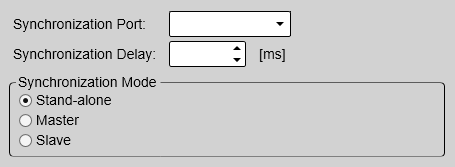Synchronization page
The purpose of the Synchronization parameters is to set up the ST90 system to operate alone, or as a master or slave in a synchronized system. Synchronization is required in order to avoid interference if the ST90 system is used simultaneously with other hydroacoustic instruments within the same frequency range.
Prerequisites
The Installation dialog box is not available when your ST90 system is set to Replay mode.
How to open
This page is located in the Installation dialog box. To open the page, select Installation on the Setup menu.

Description
Whenever more than one hydroacoustic system is installed on a vessel, interference may occur. To avoid interference, you have these options:
- The systems are all connected to a common synchronization system.
- One of the acoustic systems is set up as "master", and controls the transmissions on the other systems.
The ST90 system offers functionality for remote transmit synchronization. It can be set up to operate in either Master or Slave mode.
In physics, interference is the phenomenon in which two waves superpose each other to form a resultant wave of greater or lower amplitude. Interference usually refers to the interaction of waves that are correlated or coherent with each other, either because they come from the same source or because they have the same or nearly the same frequency. Interference effects can be observed with all types of waves, for example, light, radio, acoustic, surface water waves or matter waves.
https://en.wikipedia.org/wiki/Wave_interference — April 2016
When you work in the Installation dialog box, you must always select Apply to save the changes made on a page. You must do this before you continue working on a different page.

Details
- Synchronization Mode
Choose which synchronization mode to use.
For "slave" operation, a remote system (for example K-Sync or Simrad TU40) must be available to provide trigger pulses.
For "master" operation, a remote hydroacoustic system (sonar, echo sounder) is connected. This remote system must be set up in "slave" mode.
- Synchronization Delay
This delay parameter is used differently depending on the chosen synchronization mode.
- Synchronization Port
This is the interface port currently used to transmit or receive synchronization signals. Since the synchronization function only uses the Request To Send (RTS) and Clear To Send (CTS) signals on a serial port, you may be able to use a port that is already assigned other interface purposes. For the same reason, you do not need to define any baud rate.
